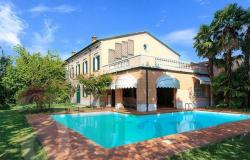As you walk from Pavia’s train station towards its historical center, you'll spot a 26-foot-tall woman holding a shield in one hand and a spear in the other, presiding over a traffic circle.
This marble and bronze relic of fascist art, created by Francesco Messina in 1938, is the Roman and Greek goddess Minerva. She represents wisdom (for the city’s academic history, since the University of Pavia, established in 1361, is among the oldest in the world), and war (for Ticinum, a Roman city founded in 220 BCE for the river of the same name on its banks).
Ticinum was a key defense outpost for the Romans. Beginning in 620, Pavia was the Lombard Kingdom’s capital and its rulers’ main residence. In 1359, the Milanese Visconti dynasty extended its sovereignty to Pavia, funding the construction of many of the churches and other monuments that you’ll see in the city today.
With this robust past, you may wonder why Pavia isn’t better-known. The city is most commonly visited for its Certosa (which isn’t in the city, but a short train ride away) and known for its university. But cobblestone streets, hidden courtyards, monumental churches — and empty sidewalks — make it a pleasant place to explore.
Certosa di Pavia

Certosa means Carthusian monastery, and Pavia’s Certosa was built as a family mausoleum for the Visconti from 1396 until 1495 on its hunting grounds. Monks still live here and lead tours at specific hours (check the website to confirm days and times). If you travel to Pavia by train, you’ll see the monumental structure as soon as you arrive. Follow a path that snakes around a brick wall and through the countryside until you reach the entrance. The facade is covered in reliefs, inlaid marble, and statues similar to the Duomo of Milan, with subjects spanning Roman emperors, scenes from the life of Christ, and tributes to Gian Galeazzo Visconti, whose tomb is inside the church.
Visconti Castle Civic Museum

Once a fortress and residence for Lord of Milan Galeazzo II Visconti and his son, the castle was partially destroyed in the 16th century during a French attack. Its restoration was completed in the 1940s and today you can visit it as a museum with a picture gallery, archaeological collection and temporary exhibitions. Pavia’s history is also examined with a reconstruction of Ticinum and Lombard ruins in the Sala Longobarda. You can also tour the castle’s courtyard, portico and loggia, and the grounds outside are pleasant for a walk or picnic.
University of Pavia and Botanical Garden

In 1778, Antonio Scopoli planted a Plane Tree in what is today the University of Pavia’s botanical garden. When it was named one of the monumental trees of Italy in 2021, it was 147 feet or 13 stories high. Along with the Plane Tree, which is at the center of the 5-acre garden, there are 30 types of gladiolas, two Japanese Pendula trees, a small Redwood grove, a collection of peonies and even a small vineyard. Three greenhouses aren’t open to the public, but you can see their tropical residents through glass walls. While you’re near the university, visit the Archaeology Museum and University History Museum in Palazzo Universitario. In Piazza Leonardo da Vinci, three medieval towers stand, testaments to the wealth and power of different noble families of the period.
San Pietro in Ciel d’Oro
Despite its simple brick Romanesque exterior, inside this church you can see treasures including the tomb of Saint Augustine and a gold leaf mosaic ceiling (giving the church its name, “Saint Peter in the Golden Sky”). Climb stairs on the right side to see the white marble arc which is the final resting place for the theologian whose teachings helped lay the foundation of modern Christianity. The church was founded in 604 and consecrated in 1132. The bishop from Hippo’s remains are yet another example of Pavia’s former grandeur — the Lombard King Liutprand had the relics moved in the 8th century from Sardegna to San Pietro in Ciel d’Oro.
Palazzo Broletto and the Duomo

A broletto was a gathering place in the Middle Ages, and you can visit Pavia’s next to its 15th-century Duomo. The church, built over two 6th- and 7th-century cathedrals — Santo Stefano and Santa Maria Maggiore, known as Santa Maria del Popolo — has a dome that stands fourth in size in Italy behind St. Peter’s and the Pantheon in Rome and Santa Maria del Fiore in Florence. Despite the church’s Renaissance plan, it was not finalized until the 1930s. A model of the cathedral is in the Pinacoteca Malaspina in the Visconti Castle Museum.
After an afternoon uncovering Pavia’s past, try its Paradise Cake — a lemon sponge cake — at Griffini or Vigoni, which are among the oldest bakeries in the city.
If you go
Pavia makes a quick day trip from Milan, taking about 40 minutes by car or on a regional train passing through farmland. With most of the major sites within walking distance from each other, you’ll gain a history lesson about Pavia and the country that is today known as Italy.









